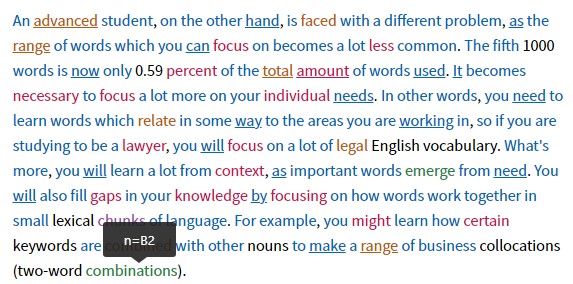This is an interesting question which depends entirely on your level of English. If you are studying English at a lower level, it is essential to learn the core, most frequent words first. This will give you the ability to understand most common forms of communication in English. Think about it! If the first 1000 most common words, make up 85.35% of all words used, your priority is be familiar with these headwords and all their inflections. The second 1000 words make up 4.12% of the total, so you can see that the higher you go up the word frequency list, the less frequent words become. So we do have to prioritise our learning if we want to succeed.
Most Advanced Learner Dictionaries mark the top 3000 items, and the definitions are all written using these most frequent words. The register of most language course books is determined by these words, so a book at A1 level will only deal with the first 1000 or so. Most teachers will adapt their use of spoken English to the first 2000 words, so that their beginner students can understand what they are saying.
An advanced student, on the other hand, is faced with a different problem, as the range of words which you can focus on becomes a lot less common. The fifth 1000 words is only 0.59% of the total amount of words used. It becomes necessary to focus a lot more on your individual needs. In other words, you need to learn words which relate in some way to the areas you are working in, so if you are studying to be a lawyer, you will focus on a lot of legal English vocabulary. What’s more, you will learn a lot from context, as important words emerge from need. You will also fill gaps in your knowledge by focusing on how words work together in small lexical chunks of language. For example, you might learn how certain keywords are combined with other nouns to make a range of business collocations (two-word combinations).
How can I decided what words are appropriate for my level?
You can use a tool like Oxford Text Checker, to scan your text and mark the words according to level according to the Oxford 5000 word list. Let’s analyse my paragraph above. As you can see from the below result, 78% of the text is derived from A1 words (marked in blue) like: student, problem, learn, words etc. A further 10% of the words are A2 words, like focus, necessary, context, etc. About 5% are B1 words like legal, relate, range etc. The B2 and C1 levels make up 1% each respectively, such as emerge and chunks. The remaining 5 percent is unlisted, for example jargon like “collocation” or “lexical” which most students won’t need to learn. This extract of text would be good for a student at a high A2/B1 level, provided the teacher simplified the B2-C1 language and filtered out the jargon.


To sum up, focus on the top 2000 words because this is the vocabulary which will help you understand nearly 90% of spoken and written communication. Actively assess the words you are using, by using a tools such as the Oxford Text checker, or look up words in an monolingual, advanced learners dictionary, Make sure you are learning words from the Oxford 5000 most common words, which are appropriate for your level. If you are a high level student, learn new vocabulary that can help you understand your special field or areas of interest. Focus on the words and phrases which you need to express your ideas, and learn to use what you already know more effectively.
https://www.oxfordlearnersdictionaries.com/text-checker/
Photo by Amador Loureiro on Unsplash
Source of frequency data: How English is Learned by Paul Nation and Steward Webb (OUP 2017)

No responses yet